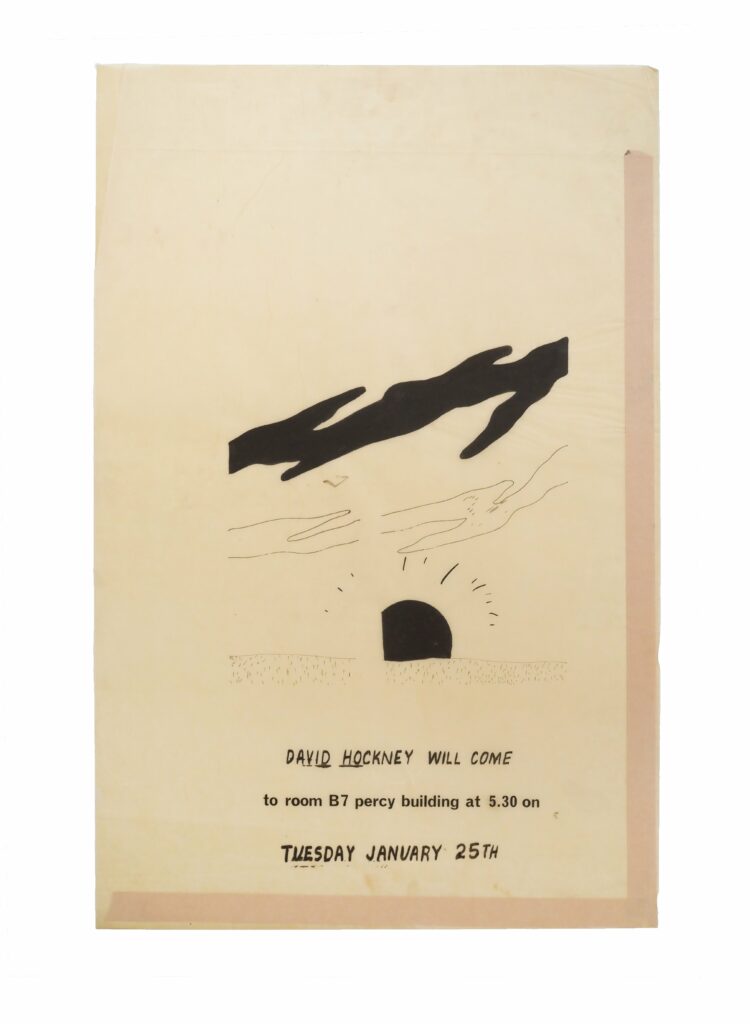This unique and stunning collection of original drawings, screenprint proofs and posters by David Hockney comprises works made to promote a lecture Hockney gave in the Percy Building at Newcastle University in 1965.
Pop artist Richard Hamilton was teaching in the art department at the time, and it was Hockney’s friend Mark Lancaster, then an art student at Newcastle, who persuaded Hockney to give an informal talk about his practice. Hockney gave the two original drawings to Lancaster, who undertook the proofing and production of the posters as original screenprints.
The motif of the palm tree which takes centre stage in this series of work is synonymous with Hockney’s paintings and prints in the sixties, first seen in his series The Rake’s Progress (1961–1963), and prints The Marriage (1962) Jungle Boy (1964) and Pacific Mutual Life (1964). The palm tree symbolises the LA landscape to which Hockney was particularly drawn and inspired.
It was also the motif that was used to illustrate the exhibition catalogue Pictures with People In. The use of black and red in these screenprints mirrors many of Hockney’s works from this decade, most notably in The Rake’s Progress.
These intriguing works on paper were from Mark Lancaster’s personal collection and one of the screentprint posters (see image to right) is inscribed to him: for Mark from David H. XXX. Lancaster, an artist, friend and travel companion of Hockney’s, visited New York in the early 1960’s and became an assistant to Andy Warhol and later to Jasper Johns.
Lancaster and Hockney travelled extensively together to Hawaii, Japan, Hong Kong, Bali, Bangkok and Burma and remained close friends until his death.
The edition size of the poster is unknown but was likely extremely small given it was printed by Lancaster to promote a one-off afternoon lecture. The only other known copy of the screenprint poster is held in the Tyne & Wear Archives.












Mark Lancaster, an artist, friend and travel companion of Hockney’s, visited New York in the early 1960’s and became an assistant to Andy Warhol and later to Jasper Johns. Lancaster and Hockney travelled extensively together to Hawaii, Japan, Hong Kong, Bali, Bangkok and Burma and remained close friends until his death.
In the 1960s British artists began to use screen-printing which suited both hard edged Abstractionist and Pop Art imagery, inspired by the example of American artists working in New York earlier in the decade. The Sixties was a period of tremendous technical advancement during which historic methods such as etching and lithography were supplemented by screen-printing and digital-printing techniques. Printmaking underwent a marked elevation in status and transition from a specialist medium to one widely adopted by some of the foremost names in contemporary art, Hockney and Hamilton were two who eagerly engaged with the innovations and freedoms of the printmaking process.
Richard Hamilton’s first forays into printing began with experiments in screen-printing, as seen in his early works from 1963 and printmaking became an essential part of his practice. Mark Lancaster’s earliest screenprints date back to 1965, the year he and Hockney produced these works, which are an important and early example of screen-printing in Britain, as well as in Hockney’s own printmaking oeuvre.
David Hockney’s lecture at Newcastle University took place a year after the ‘6 Young Painters’ Arts Council touring exhibition which was held in the city from 2nd – 22nd February 1964 and included five paintings by David Hockney. Fellow artists featured in the exhibition included Bridget Riley and Peter Blake. In the foreword of the exhibition catalogue it said: ‘This is the fifth in a series of exhibition organised by the Arts Council to give the public outside London the opportunity of seeing the work of artists whose names are becoming established in this country and indeed abroad. The variety of styles is deliberately chosen to show a representative cross-section of the present aims and methods of the younger generation of British painters’.
By 1965 David Hockney had already gained recognition having left The Royal Collage of Art in 1962 and he had his first solo exhibition of paintings ‘Pictures with People In’ at the Kasmin Gallery in London in 1963. The sixties were an important and formative time for Hockney who had visited Egypt in 1963 and spent an increasing amount of time in the US, mainly in California.